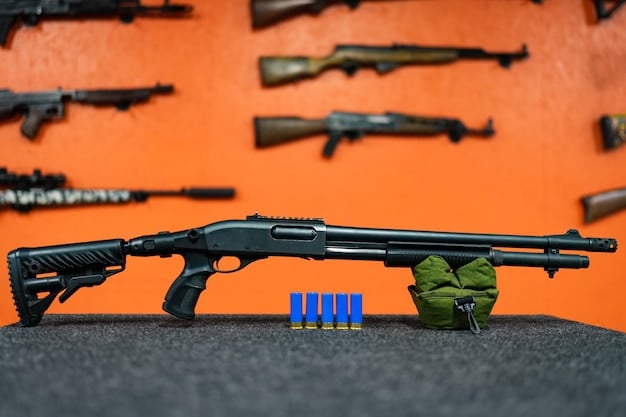Navigating Gun Control: Debates and Proposed Solutions in the US

What are the current debates surrounding gun control legislation, and what are the proposed solutions? The US continues to grapple with this issue, facing discussions about the Second Amendment, mental health, and public safety. Proposed solutions range from universal background checks to banning certain types of firearms.
The issue of gun control in the United States remains a deeply divisive and complex topic. What are the current debates surrounding gun control legislation, and what are the proposed solutions? This question sparks heated discussions among policymakers, advocacy groups, and everyday citizens alike.
Navigating the nuances of gun control requires a thorough understanding of the various perspectives and legislative proposals. This article aims to explore the key arguments and potential solutions shaping the future of firearm regulation in the US.
Understanding the Core of Gun Control Debates
The debates surrounding gun control legislation are multi-faceted, rooted in differing interpretations of the Second Amendment and concerns about public safety. Understanding these core issues is crucial for informed discussions.
The Second Amendment: Individual Right vs. Collective Security
A central debate revolves around the interpretation of the Second Amendment, which guarantees the right to bear arms. Some argue it protects an individual’s right to own guns for any purpose, while others believe it applies only to militias.
- Individual Rights Advocates: Emphasize personal freedom and the right to self-defense.
- Collective Security Proponents: Prioritize public safety and believe the government has the right to regulate firearms.
- Historical Context: Understanding the historical context of the Second Amendment can shed light on its original intent.
These differing views form the philosophical bedrock for many of the disagreements surrounding gun control legislation.
Mental Health and Gun Violence
Another significant area of debate concerns the relationship between mental health and gun violence. While most individuals with mental illness are not violent, there is concern about access to firearms for those with specific mental health conditions.
- Background Checks: Expanding background checks to include mental health records is a common proposal.
- Red Flag Laws: These laws allow temporary removal of firearms from individuals deemed a danger to themselves or others.
- Mental Health Resources: Improving access to mental health care can address underlying issues that may contribute to violence.
Addressing the intersection of mental health and gun violence requires a balanced approach that respects individual rights while prioritizing public safety.

In summary, understanding the core debates concerning the Second Amendment and the connection between mental health and gun violence is crucial to analyzing what are the current debates surrounding gun control legislation, and what are the proposed solutions? This understanding is the foundation for a more informed discussion.
Proposed Solutions: Strengthening Background Checks
One of the most widely discussed solutions involves strengthening the existing background check system to prevent firearms from falling into the wrong hands.
Universal Background Checks
Proponents of universal background checks argue that all gun sales, including those between private citizens, should require a background check to ensure individuals prohibited from owning firearms cannot acquire them easily.
Currently, many states do not require background checks for private gun sales, creating a loophole that allows individuals with criminal records or mental health issues to purchase firearms.
Closing Loopholes and Expanding Databases
In addition to universal background checks, proposals include closing existing loopholes and expanding the databases used for background checks. This involves:
- Closing the Charleston Loophole: This loophole allows gun sales to proceed if a background check is not completed within three business days.
- Expanding NICS Database: Ensuring all relevant records, including mental health and domestic violence convictions, are included in the National Instant Criminal Background Check System (NICS).
- Regular Audits: Conducting regular audits of the NICS system to identify and address any deficiencies.
Strengthening background checks represents a key strategy in reducing gun violence by preventing prohibited individuals from acquiring firearms.
Implementing stronger background checks may significantly decrease gun violence by restricting access to guns for individuals who are legally prohibited from owning them, directly addressing what are the current debates surrounding gun control legislation, and what are the proposed solutions?
Banning Assault Weapons and High-Capacity Magazines
Another controversial proposal involves banning assault weapons and high-capacity magazines, which are often associated with mass shootings.
Defining Assault Weapons
The definition of “assault weapon” is a subject of debate, but it generally refers to semi-automatic firearms with military-style features, such as detachable magazines and pistol grips.
These firearms are often perceived as being more dangerous than other types of guns due to their high rate of fire and potential for causing mass casualties.
Arguments for and Against Bans
The debate over banning assault weapons and high-capacity magazines involves strong arguments on both sides.
- Proponents of Bans: Argue that these weapons are not suitable for civilian ownership and contribute to the severity of mass shootings.
- Opponents of Bans: Claim that these weapons are commonly used for self-defense and that a ban would infringe on Second Amendment rights.
- Effectiveness of Bans: Research on the effectiveness of assault weapon bans has yielded mixed results, with some studies showing a decrease in gun violence and others showing no significant impact.
The arguments against bans highlight the concern that such measures may not be effective in preventing crime and could negatively impact law-abiding gun owners.

Banning assault weapons remains a contentious issue in what are the current debates surrounding gun control legislation, and what are the proposed solutions? Understanding the nuances of these arguments is essential for developing effective gun control policies.
Red Flag Laws: Balancing Rights and Safety
Red flag laws, also known as extreme risk protection orders, allow temporary removal of firearms from individuals deemed a danger to themselves or others.
How Red Flag Laws Work
These laws typically allow family members, law enforcement, or school officials to petition a court to temporarily remove firearms from an individual who poses a significant risk of harm.
The court must find clear and convincing evidence that the individual is a danger before issuing an order. The order is typically temporary, and the individual has the right to a hearing to contest the order.
Concerns and Safeguards
While red flag laws are intended to prevent tragedies, they also raise concerns about due process and potential abuse. To address these concerns, many red flag laws include safeguards such as:
- Clear Evidentiary Standard: Requiring clear and convincing evidence of a threat.
- Due Process Protections: Providing individuals with notice and an opportunity to be heard in court.
- Temporary Orders: Limiting the duration of orders and requiring periodic reviews.
Finding the right balance between protecting public safety and safeguarding individual rights is crucial in implementing effective red flag laws.
Successfully implementing red flag laws relies on striking a balance between safeguarding the public and upholding individual rights while considering what are the current debates surrounding gun control legislation, and what are the proposed solutions?
Community-Based Violence Intervention Programs
In addition to legislative measures, community-based violence intervention programs are gaining recognition as an effective way to reduce gun violence.
Focus on At-Risk Individuals
These programs focus on identifying and working with individuals at high risk of being involved in gun violence, either as victims or perpetrators.
They often involve outreach workers who build relationships with these individuals and connect them with resources such as job training, counseling, and conflict resolution services.
Evidence-Based Strategies
Effective community-based violence intervention programs utilize evidence-based strategies, such as:
- Focused Deterrence: This strategy involves directly communicating with at-risk individuals about the consequences of gun violence.
- Cognitive Behavioral Therapy: This therapeutic approach helps individuals change their thinking patterns and behaviors.
- Street Outreach: Outreach workers engage with individuals in their communities to de-escalate conflicts and provide support.
Investing in community-based violence intervention programs is a proactive approach to reducing gun violence by addressing the root causes and providing individuals with alternatives.
By approaching violence as a public health issue and using data-driven methods, community-based programs offer a unique avenue to address what are the current debates surrounding gun control legislation, and what are the proposed solutions?
| Key Point | Brief Description |
|---|---|
| 🛡️ Second Amendment | Debates on individual rights vs. collective security. |
| 🔍 Background Checks | Strengthening systems to prevent gun access by prohibited individuals. |
| 🚩 Red Flag Laws | Temporary gun removal from those posing a risk. |
| 🤝 Community Programs | Violence intervention focusing on at-risk individuals. |
Frequently Asked Questions
Arguments for stricter gun control emphasize public safety, while arguments against prioritize Second Amendment rights and self-defense.
Red flag laws allow temporary removal of firearms from individuals deemed a danger to themselves or others, following a court order.
Proposed solutions include universal background checks, banning assault weapons, and implementing red flag laws to help reduce gun violence.
These programs focus on identifying at-risk individuals and providing resources like job training and counseling to reduce violence.
Considerations include balancing Second Amendment rights with public safety, and ensuring proposed solutions are effective and equitable.
Conclusion
The debates surrounding gun control in the US are complex and deeply rooted in differing values and priorities. Addressing what are the current debates surrounding gun control legislation, and what are the proposed solutions? requires a multifaceted approach.
By understanding the core arguments, considering various legislative proposals, and investing in community-based solutions, we can work towards a safer and more secure future for all.





